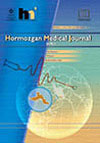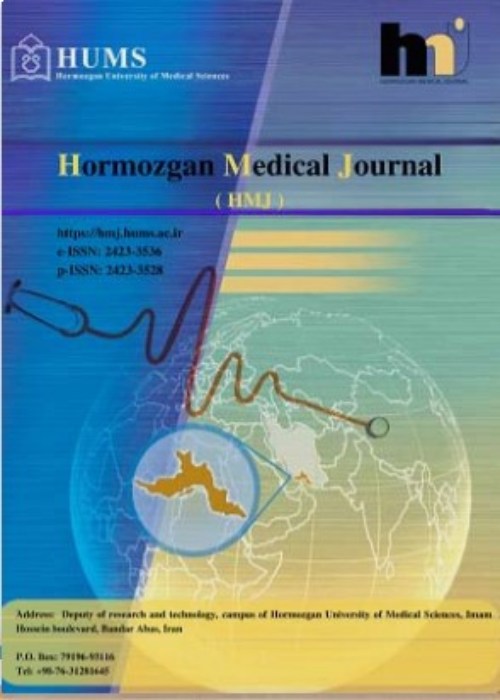فهرست مطالب

Hormozgan Medical Journal
Volume:24 Issue: 4, Dec 2020
- تاریخ انتشار: 1399/07/29
- تعداد عناوین: 9
-
-
Page 4
Studies have documented criteria for the prevention, diagnosis, and treatment of COVID-19 pneumonia as more information has become available about its symptoms and complications. Similar to other coronavirus-induced cases of pneumonia, COVID-19 pneumonia causes acute respiratory problems. The chest CT scan, which is easily available in almost all areas, is a common imaging technique for diagnosing pneumonia. Its findings, which are accompanied by high speed, quality, and accuracy, allow the radiologist to easily identify affected areas of the lungs and to determine typical radiological features of patients with pneumonia caused by COVID-19. These features include ground-glass opacity, multifocal patchy consolidation, and interstitial changes with the peripheral distribution. The highest incidence occurs in the 4th and 5th lobes, where about 50% to 75% of the lesions observed. For infected patients, the CT scan protocol includes administration of HRCT technique in the inspiration phase with spiral 4-slice devices and higher. Scan parameters also include KV: 100 - 120, and mAs: 20 - 30, thickness = 1 - 2 mm, spiral, single breath-hold, and Pitch = 0.8 - 1.5, which are determined for all patients. Since there are restrictions on using ionizing radiation for pregnant women, it is recommended to initially conduct PCR tests. If necessary, typical radiography with an abdominal shield can be used for women in the first trimester of pregnancy, and the HRCT technique in low doses can be used for those in the second and third trimesters.
Keywords: CT Scan, COVID-19, Typical Symptoms, Ground Glass, CT Scan Follow-Up -
Neurological Involvement of Patients with COVID-19: Proposed Neuroinvasive Mechanisms and ManagementPage 5
The novel Coronavirus Disease 2019 (COVID-19) is a highly contagious virus that has caused tremendous chaos in the world. Generally, respiratory symptoms are dominant manifestations in patients with COVID-19. However, the involvement of other organs, such as the nervous system has also been reported, which elucidates the capability of the virus to induce multi-organ failure. In this regard, the presentation of neurological symptoms in infected patients has raised the concern regarding the neuroinvasive potential of COVID-19. As of today, there is emerging evidence that supports the susceptibility of the nervous system to COVID-19. Undoubtedly, the awareness of these findings can result in the timely management and treatment of patients. In the present article, we documented a brief overview of neurological manifestations, possible neuroinvasion mechanisms of COVID-19, and the management of neurological symptoms in infected patients.
Keywords: COVID-19, Neurological Symptoms, Neuroinvasive -
Page 6Introduction
Children are sensitive at any age to coronavirus disease 2019 (COVID-19) and are at risk of being infected. The prevalence of this disease in children under ten years of age is reported to be 1%. The most common clinical manifestation of COVID-19 in children is acute respiratory distress syndrome (ARDS). Nursing management is an important part of the treatment in children with ARDS. Owing to the emergence of COVID-19 and less focus on studies in pediatrics, the present study reports a case of COVID-19 in an 8-year-old child and its caring issues.
Case PresentationThis report describes an 8-year-old boy who was referred to Tabriz Children’s Hospital with respiratory symptoms such as fever, cough, and dyspnea. He was admitted to the pediatric intensive care unit. Diagnosis of COVID-19 was made based on the PCR test on the second day of hospitalization. In chest X-ray imaging, in the left lung, consolidation, and glass-opacity was observed.
ConclusionsCaring for a child with COVID-19 was a new experience for PICU nurses. The most important caring issues of a child with COVID-19 were continuous monitoring of respiratory status, paying more attention to family informational and emotional support owing to visitation bans, transmission of infection, and the difficulty of caring activities due to the limitations of the use of personal protective equipment.
Keywords: Child, Coronavirus, COVID-19, Nursing, Care -
Page 7Background
From the general health perspective, the epidemiology of COVID-19 in Hormozgan Province, a region in the south of Iran marked by heavy traffic, can provide useful information to help control the epidemic of the disease in other provinces and the whole country.
ObjectivesThus, the present research aimed to epidemiologically analyze COVID-19 patients and patients with severe acute respiratory infection (SARI) based on hospital data in Hormozgan Province.
MethodsIn the present observational, analytical, cross-sectional study, the epidemiologic data of all 2,055 patients with the symptoms of acute respiratory problems who visited hospitals in Hormozgan between February 20, 2020, and April 19, 2020, were analyzed and reported. Patients’ demographic information included gender, age, and background diseases. Tabulated data, frequencies, and percentages were used for descriptive statistics, and the chi-squared test and odds ratios were used for inferential statistics.
ResultsThe ratios of male to female among people with COVID-19 and respiratory infection were 1.15 and 1.12, respectively. The mean age of the participants was 42.8 ± 21 years. The results revealed that contact with patients had the highest odds ratio (5.41 - 9.30, OR = 7.09) regarding COVID-19 as compared to SARI. Reduced sense of smell (1.86 - 12.87, OR = 4.89), muscular pain (1.24 - 2.14, OR = 1.63), coughs (1.14 - 1.86, OR = 1.46), and fever (1.14 - 1.83, OR = 1.45) showed to have the highest odds ratios concerning the symptoms. As for background diseases, cardiovascular disease (1.004 - 2.110, OR = 1.455), asthma (OR = 1.603, 1.040 - 2.473), and pulmonary chronic disease (1.456 - 3.854, OR = 2.369) had the highest odds ratios.
ConclusionsThe present findings showed a statistically significant correlation between age and affliction with COVID-19. Moreover, the most prevalent symptoms of the disease were reduced sense of smell, muscular pain, coughs, and fever, as already mentioned in similar studies. The present research showed that patients with cardiovascular disease, asthma, or chronic pulmonary disease had the highest risk of COVID-19.
Keywords: Epidemiology, Hormozgan, COVID-19, SARS-CoV-2 -
Page 8
The coronavirus disease 2019 (COVID-19) pandemic, with a high morbidity and mortality rate, has affected all age groups. COVID-19 infection in children usually has minimal symptoms, but the number of children with the inflammatory syndrome with clinical features similar to the Kawasaki disease has increased during the COVID-19 pandemic. Information about this emerging COVID-19 manifestation also called the multisystem inflammatory syndrome in children (MIS-C), is still incomplete. Patients typically present with persistent fever, followed by shock or multi-organ involvement. Laboratory findings and clinical presentation of this multi-organ involvement is part of the diagnostic criteria. Early treatment and multidisciplinary referral to pediatric specialists are essential. The prognosis of MIS-C is not yet fully understood. Although most children survive, several deaths have also been reported. Based on relevant evidence, this study aimed to review the pathophysiology, clinical manifestations, laboratory and imaging findings, diagnosis, treatment recommendations, and prognosis of MIS-C associated with COVID-19.
Keywords: Children, Kawasaki Disease, COVID-19, Inflammatory Syndrome -
Page 9Background
Coronavirus disease 2019 (COVID‐19) caused by severe acute respiratory syndrome coronavirus 2 (SARS‐CoV‐2) infection has been widespread.
ObjectivesWe aim to investigate the demographic and clinical characteristics associated with COVID-19 infection between January 24 to June 10, 2020.
MethodsAll data related to tested patients (positive and negative cases) were extracted from the integrated health information system (IHIS) between January 24 to June 10, 2020. Statistical analyses were performed using data related to the anamnesis of all patients, odds ratios (OR) of COVID-19 infection in defined subgroups including contact history, partial pressure of oxygen (PO2) higher than 93 mmHg, the muscle-pain symptom, the cough symptom, and the fever symptom.
ResultsThe COVID-19 infection was significantly associated with contact history (OR 5.25, [95% CI 4.35 to 6.34], P-value < 0.0001); PO2 higher than 93 mmHg (OR 1.74 [95% CI 1.44 to 2.22], P-value < 0.0001); muscle-pain symptom (OR 1.89 [95% CI 1.58 to 2.26], P-value < 0.0001); cough symptom (OR 1.32 [95% CI 1.14 to 1.53], P-value < 0.0001); and fever symptom (OR 1.29 [95% CI 1.11 to 1.49], P-value = 0.0004).
ConclusionsThe results of our study indicated that contact with patients or suspicious individuals can be considered as the most important symptoms of COVID-19 disease. Furthermore, the high pressure of oxygen, muscle-pain, cough, and fever symptoms were identified as considerable symptoms of COVID-19 disease.
Keywords: Iran, Hormozgan, 2019-nCoV, COVID-19 Infection, Demographic, Clinical Characteristics


